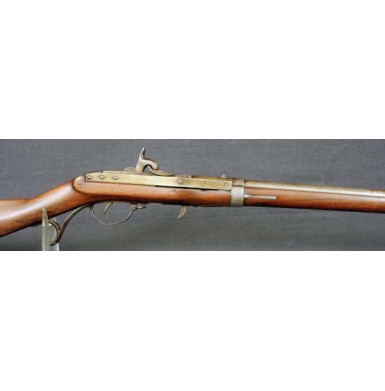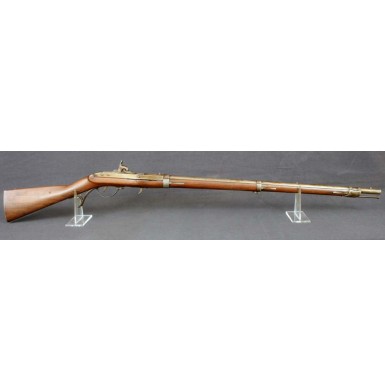Confederate Altered Hall Rifle attributed to South Carolina
- Product Code: FLA-1486-SOLD
- Availability: Out Of Stock
-
$1.00
With the coming of the American Civil War, thousands of Hall’s Patent M-1819 Flintlock Rifles were in store at state and Federal armories throughout the southern states. In the state of South Carolina, approximately 500 Hall rifles were in the Federal Arsenal in Charleston, and somewhere around 100 Hall rifles that were older South Carolina state property were in the state armories in Charleston and Columbia. These state property rifles had been received as part of the Militia Act of 1808 and many had seen use during the Seminole Wars. An interesting, and rarely referenced stipulation of the Militia Act of 1808 was that it prohibited the issue of US arsenal made weapons to the states, if the weapon was the current model in use. This meant that while the Hall rifle was a current production weapon at Harper’s Ferry, only those Hall’s made under contract by Simeon North could be issued to the states under the Militia Act. Once a weapon was relegated to second-class or obsolete status, it could be delivered to the states under the militia act, no matter where it had been manufactured. As a result, the guns that were South Carolina property from the Seminole War era were Simeon North contract Hall rifles. These pre-CivilWar state owned guns were marked by the state with the ownership mark S. CAROLINA on the upper left side of the receiver. The handful of rifles that were so marked (somewhere between 75 and 166) have become essential in the identification of otherwise unmarked Confederate altered Hall rifles that have been attributed to the state of South Carolina. Two styles of conversions have been encountered on the Hall rifles that bear the S. CAROLINA ownership mark. One style has a ungainly alteration hammer that is brazed to the bottom of the original flintlock hammer, and strikes a cone that is set at a nearly 90-degree angle to the breech block. The other style utilizes a completely new percussion hammer that is much smaller than the conversion hammer encountered on US arsenal converted Hall rifles. Both styles of conversion leave the original pan fence in place, do not fill the bottom of the pan, and install the cone directly in the old flintlock vent. These conversions also often leave the frizzen toe hole unfilled in the breechblock. Since the breechblock was not filled and machined flat like it was with most Confederate Hall alterations, the breechblock markings tend to remain in tact. These two styles of conversions are well documented on pages 314-319 of Dr. John Murphy’s & Howard Madaus’s Confederate Rifles & Muskets. One of the examples in the book has a Simeon North contract breechblock, but the gun is mounted with barrel bands that are retained by pins, not band springs. Prior to 1830, all Harper’s Ferry production Hall rifles were assembled with band springs, and since the sample provided to North was of this style all of his contract rifles were manufactured with band springs. Only post-1830 Hall rifles, produced at Harper’s Ferry exhibit bands retained by pins. So, the North produced breechblock was installed in a Harper’s Ferry produced gun, likely during the conversion process. The South Carolina attributed Hall alteration offered here has the same type of “swapped parts’ assembly. The breechblock is 1832 dated and Harper’s Ferry marked. However, the barrel bands are retained by springs, indicating the rest of the rifle is either pre-1830 Harper’s Ferry production or from the Simeon North contract. The breechblock has the second style “South Carolina” conversion hammer, which is of completely new manufacture. The bottom of the hammer (only visible when the breech block is removed) is marked with the reassembly number XIII. Like other South Carolina conversions, the original flintlock fence remains on the top of the breechblock and the cone is installed directly in the original flintlock vent. The toe hole of the breechblock has been filled, but the block has not been machined or flattened as with other Confederate conversions. As with Murphy’s example discussed on page 318, this hammer is plain and not knurled. The breechblock may have been marked with alteration numbers at the time of conversion, but no marks can be clearly seen on the block currently.
The rifle is in VERY GOOD condition overall. The side of the breechblock still retains strong traces of case coloring. The action of the rifle works exactly as it should, both the breech latching and opening system and the hammer and trigger system. The rifle retains both of its original sling swivels. The original Hall rifle rear site and off-set front site / bayonet lug are in place on the rifle as well. A wonderful, locally made Confederate replacement iron rammer / cleaning rod is in place under the barrel. It is complete, fully length and still retains threads at the end. The gun has a lovely, untouched mottled gray brown patina, that is mostly smooth throughout with only scattered areas of light to moderate peppering and pinpricking. The bore of the rifle rates about good. The bore is dark, with strong rifling and light to moderate scattered pitting along its entire length. The stock rates NEAR VERY GOOD with no breaks or repairs. The stock exhibits the usual handling bumps and dings from service, but does not show any abuse. There is some minor grain cracking just forward of the metal plate that surrounds the breechblock release lever. This appears to be the result of stress cracking from the breechblock locking system. There may have been a small reassembly number stamped into the wrist of the stock just to the left rear of the breechblock, but it has worn to be illegible. The stock has a lovely, un-cleaned and untouched look that matches the attractive look of the metal of the rifle. There is an illegible cartouche stamped on the upper edge of the butt stock, just forward of the butt plate. It may have been an SC at one point, but it is not clear enough to decipher now.
Overall this is a really attractive, completely untouched example of a rarely encountered Confederate Hall rifle alteration, attributed to the state of South Carolina. These unique Confederate state Hall alterations exist in very limited numbers today and in many cases were made in very small quantities. It is unlikely that there are more than a handful of these South Carolina conversions still in existence today. These rare rifles are a real bargain in the field of Confederate arms collection, as they tend to be priced at less than half the price of a comparable condition Richmond rifle musket, and many thousands of those guns were produced!
Tags: Confederate, Altered, Hall, Rifle, attributed, to, South, Carolina




